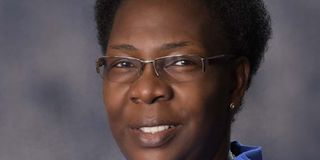Voiceless girl mothers: A litmus test of our commitment to gender equality in Africa
Sponsored by FAWE

By Martha Muhwezi
It was former First Lady of the United States, Mrs Michelle Obama, who said: “No country can ever truly flourish if it stifles the potential of its women and deprives itself the contribution of half its citizens”. She said this at the 2014 Summit of the Mandela Washington Fellowship for Young African Leaders.
Indeed, the contribution of women to any country’s social and economic progress cannot be understated.
According to a journal by Exploring Economics, women around the world perform two-thirds of the work for 10 percent of the income and one percent of the assets. A whopping 70 percent of the world’s poor also happen to be women.
In the Global Gender Gap Report 2020, the World Economic Forum places Iceland as the most gender-equal country in the world for the 11th time in a row, having closed almost 88 percent of its overall gender gap, further improving since 2019.
Closer home, the report states that Sub-Saharan Africa has closed 68 percent of its gender gap so far – a significant improvement from 2019. Notably, the best-performing countries in Sub-Saharan Africa include Rwanda and the DRC, while the most improved country is Ethiopia, having reduced its overall gender gap by five percent.
Though a majority of countries in the world continue to report great improvements, more still needs to be done to achieve gender equality. This is especially true in the case of Africa, whereby McKinsey reports that the overall progress toward gender equality has stalled over the past four years. At the current rate of progress, it would take Africa more than 140 years to reach gender parity. Unfortunately, this is being exacerbated by the current Covid-19 global pandemic.
At the receiving end of the pandemic’s brutal effects is the African girl. The continent has been aroused by the numerous cases of gender-based violence, especially the spiking number of girls who have been subjected to teenage pregnancies.
Taking Kenya as an example, cases of teenage pregnancies have hit an all-time high with the school closures due to Covid-19.
The Global Citizen estimates that over the period between July and August 2020, 152,000 Kenyan girls became pregnant. This is a 40 percent increase in the country’s monthly average.
Girls are also at risk of gender based violence as they are the most vulnerable demographic. When a girl gets pregnant, her chances of continuing with education dwindle. One is left to ponder, have we neglected our girls? Are schools safer than our homes? Are our girls suffering in silence?
Further, studies have proven that teenage pregnancies are precursors of child marriage. The thousands of girls that have been impregnated by either their peers or rogue adults during Covid-19 might end up being heads of child households. These are girls who have zero skills on how to be mothers at their age and so the ripple effects are detrimental to their lives. While all this happens, their counterparts, the boys, are more likely to continue with their studies, as culturally, their domestic load of care is much lighter.
There couldn’t be a harder time to be an African female adolescent as this. This is because most African countries have not yet embraced the reintegration of teenage mothers in school systems. Meaning, as African countries prepare for a reopening, the new teenage mothers will join the soaring number of out of school children in Sub-Saharan Africa.
As we mark the International Day of the Girl under the theme, “My voice, our equal future”, we are called upon to rekindle our relationship with our girls, remain accountable to the provision of their rights and intentionally nurture their confidence to speak out on the issues they are facing at personal and group level.
There have been numerous campaigns ignited at continental and national levels to address female genital mutilation, child marriage, teenage pregnancies and access to education. We need to gauge their effectiveness over time, including aligning them to the emerging barriers such as Covid-19.
Governments need to evaluate the effectiveness of the policies and strategies in place to address gender equality in education. They must address the glaring gaps, such as limited or zero budget allocation to gender equality and equity initiatives, and the need to build the capacities of duty bearers to understand and execute laws and policies at grassroots level. They should establish complaints or case reporting mechanisms of violence at regional, national and community levels, among other game changing measures. A litmus test on our obligation to the girl child is essential.
Furthermore, the Gender Equality Strategy for the Continental Education Strategy for Africa 16-25 (GES4CESA) commissioned by the African Union International Centre for Women and Girls Rights (AU/CIEFFA) and FAWE, is one of the significant continental tools that gives practical insights for AU member states to roll out and strengthen gender responsive solutions in the country education systems. It further encourages member states to reorient their education and training systems to ensure that as many girls and women acquire the knowledge, competencies, skills, innovation and creativity required to foster Africa’s development.
In fulfilling our obligations in integrating gender equality and equity in education as development partners, private sector partners, African Union decision makers, government, community and family leaders, we will have nurtured the girls to be mouthpieces of their individual and community issues; including shaping them to be change agents of our and their generation.
The writer is the Executive Director of Forum for African Women Educationalists (FAWE)


